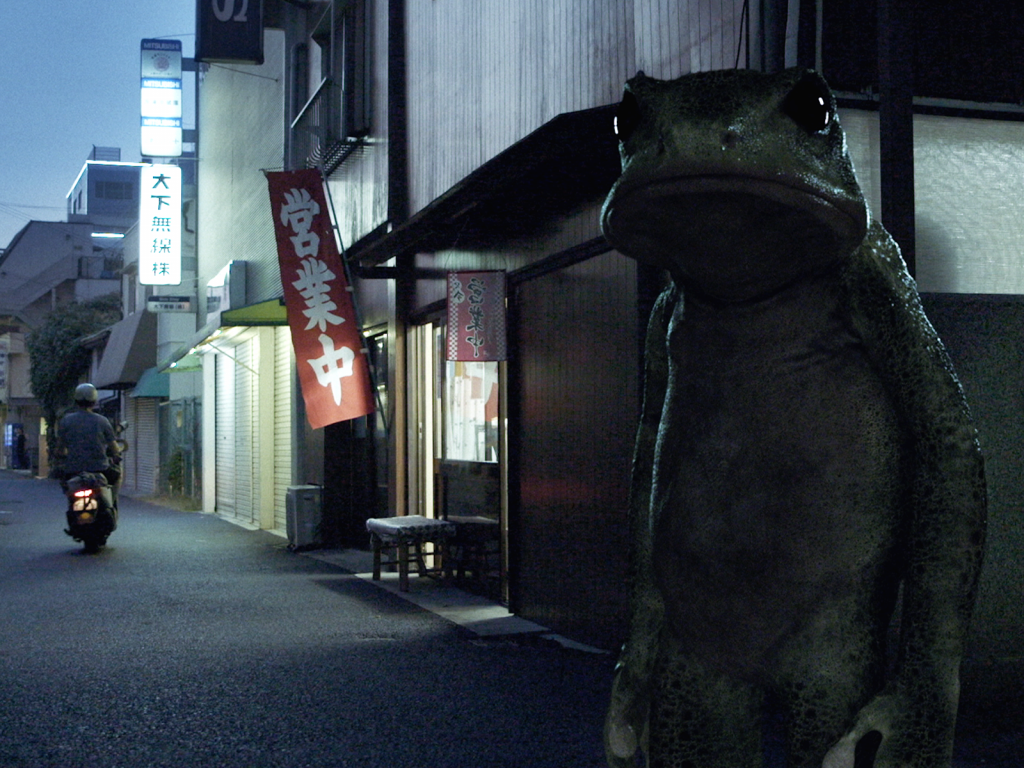Film director Nitesh Anjaan was developing a documentary on Mette Holm – the Danish translator of Haruki Murakami’s work – when an anthropomorphic frog appeared in his dreams one night. The frog was sitting on top of a skyscraper in Tokyo, surveying the cityscape, and it gave Anjaan an idea.
When he got out of bed at 5am, he went into his kitchen to jot down 15 story beats on a set of Post-it Notes. At about 8am he woke his girlfriend with breakfast and news. “I think I wrote a film,” he told her.
Those Post-its served as the outline for Dreaming Murakami, Nitesh’s second feature film. A surreal and intimate portrait of Mette, it follows her as she labors over a Danish version of the Japanese author’s debut novella, Hear the Wind Sing.
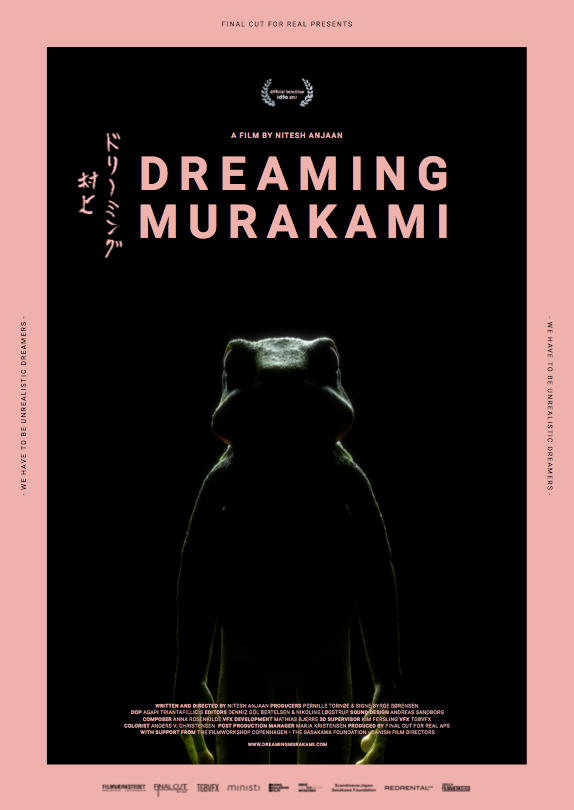
This is not a documentary about Murakami so much as it is one in which he is a MacGuffin-type plot device enabling people of diverse backgrounds to discover common ground. When it comes to examples here, one needs look no further than the pairing of director and subject.
Nitesh and Mette met in 2009. He was 21 and working on his debut novel, Kind of Blue. An avid Murakami reader, he happened upon Mette while she was giving a lecture on the author. Approaching her afterwards to talk, they soon struck up a lasting friendship.
“Nitesh would carry all my books out to the car,” Mette jokes.
“She was opening up all these questions for me in terms of authorship, translation and language,” Nitesh recalls.
“My initial idea for the film was to create a thematic documentary on Mette as a translator,” he continues. “It would have reconstructions and small references that Murakami readers would see.”
“But when I started interviewing Mette and talking about what it was like to translate books like Hardboiled Wonderland and The End of the World, she wasn’t talking like it was a book. It was like The End of the World was a place she had been. She had been to Hardboiled Wonderland, and I realized that I wanted to make a documentary of the imagination.”
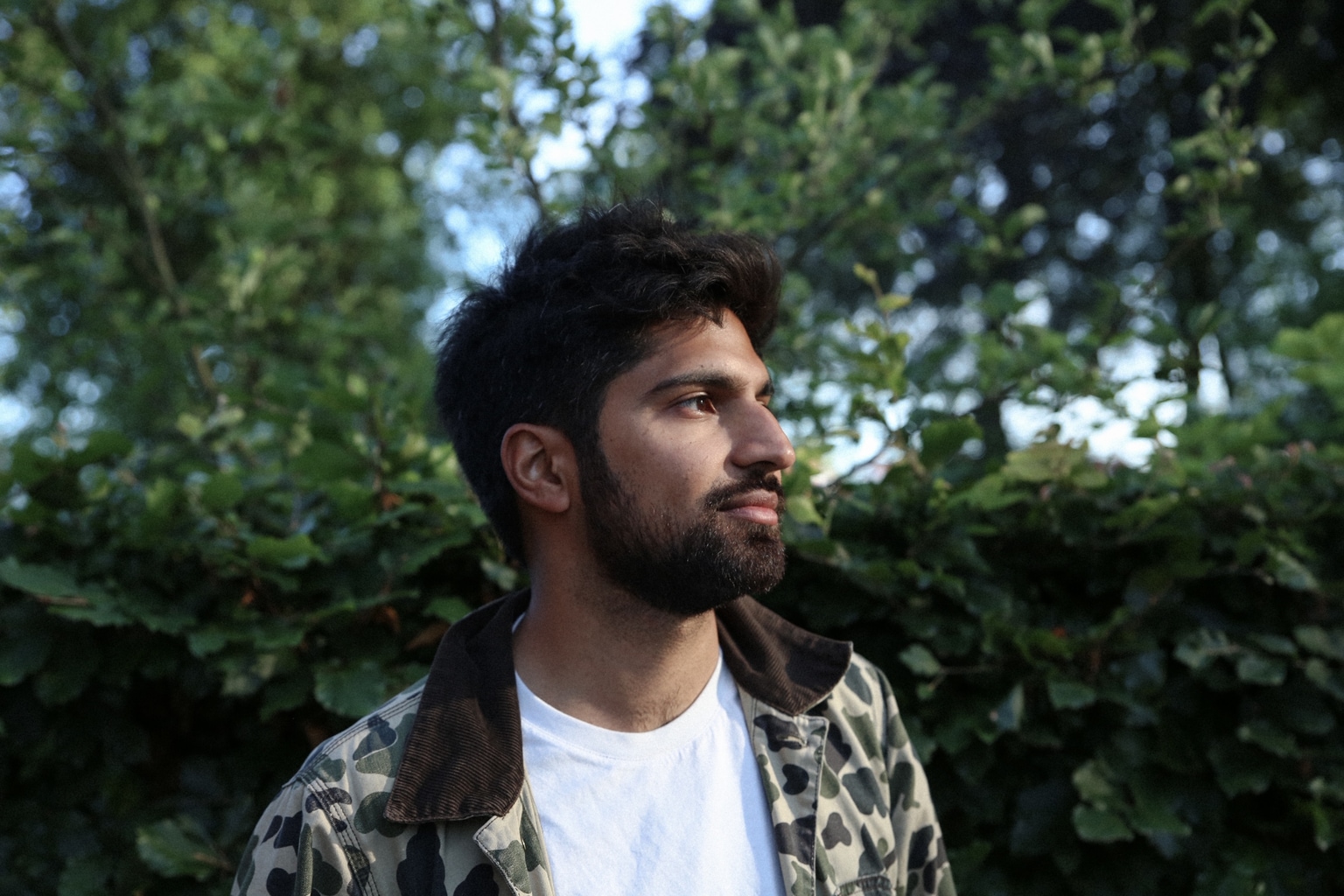
Director Nitesh Anjaan. Photo by Michella Bredahl
By the grace of his subconscious, which inserted the frog into his dreams, the wheels were set in motion. It was a moment suitably categorized as Murakami-esque, primarily due to the fact that this amphibious being resembled one of the author’s actual characters: a frog named Frog.
Frog featured in Super Frog Saves Tokyo, a short story from Murakami’s book, After the Quake. Penned during his socially conscious “commitment” period following the 1995 Tokyo subway attacks and Kobe earthquake, Super Frog is a strong indicator of the overall shift in his literary style at the time.
Set in Tokyo one month after the Kobe earthquake, the plot focuses on Katagiri, a quiet, selfless Shinjuku banker who spends much of his time collecting debt from mobsters in Kabukicho. One day, Katagiri comes home to find a six-foot-tall frog waiting for him with tea and a proposition to save the prefecture from a giant worm called Worm.
Worm has been absorbing small everyday vibrations and converting them into “hatred.” In three days’ time, this “hatred” will be unleashed as another devastating earthquake and the only way to stop it is to kill Worm. Katagiri’s role in this deadly fight is simple. He must act as a cheerleader for Frog. No matter the outcome, however, nobody will ever know of their heroic deed. “Ours is a lonely battle,” Frog tells Katagiri.
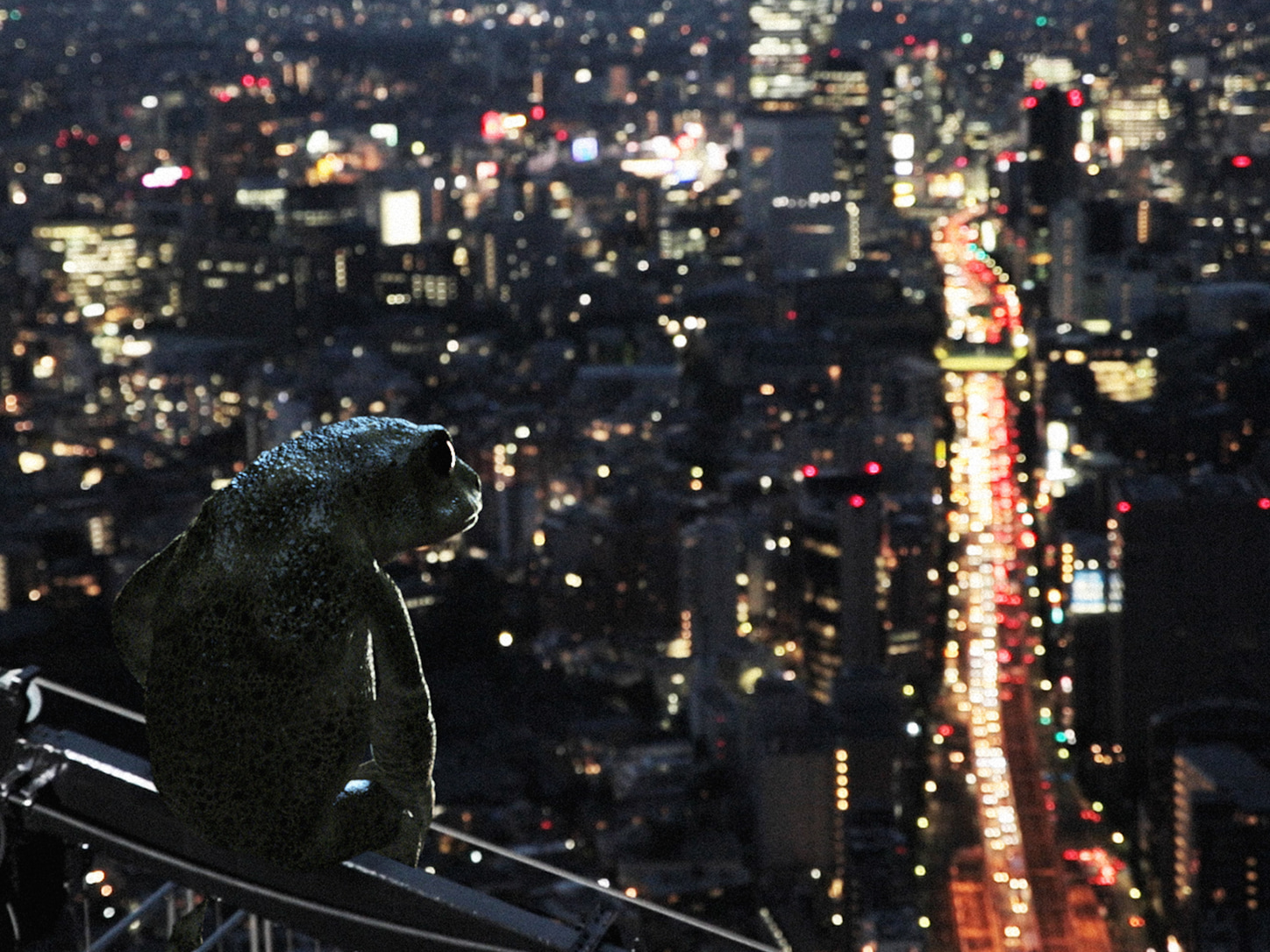
Still from the documentary Dreaming Murakami. Credit: Agapi Triantafillidis
Though ambiguous in its overall meaning, the story reads as a reflection on mounting social tensions, unsung heroes and the value of communication between those from different cultures (a frog and a human in this case). Each of these points draws a parallel with Dreaming Murakami, enough so that Frog earned his place as an on-screen character in the documentary via CGI. Only this time, he needs Mette, not Katagiri.
“I saw this frog and nobody else could see it,” Nitesh says. “I would try to direct the cinematographer and say, the frog is there and there and there. I realized that the documentary had to be what I believe in, what we believe in as story translators. It’s just as real as the physical reality, and we need to understand what the frog wanted as a character.”
Bearing a new message – a warning about the increased stronghold of right-wing politics over Japanese society – Frog trails Mette as she wanders the backstreets of Tokyo, sits in diners and speaks with bartenders and punters. It is warping reality to reveal a greater “ecstatic truth,” as filmmaker Werner Herzog would say, and the rationale makes sense. Translators bridge the gap between different nations and cultures, typically delivering their best work when nobody notices their presence.
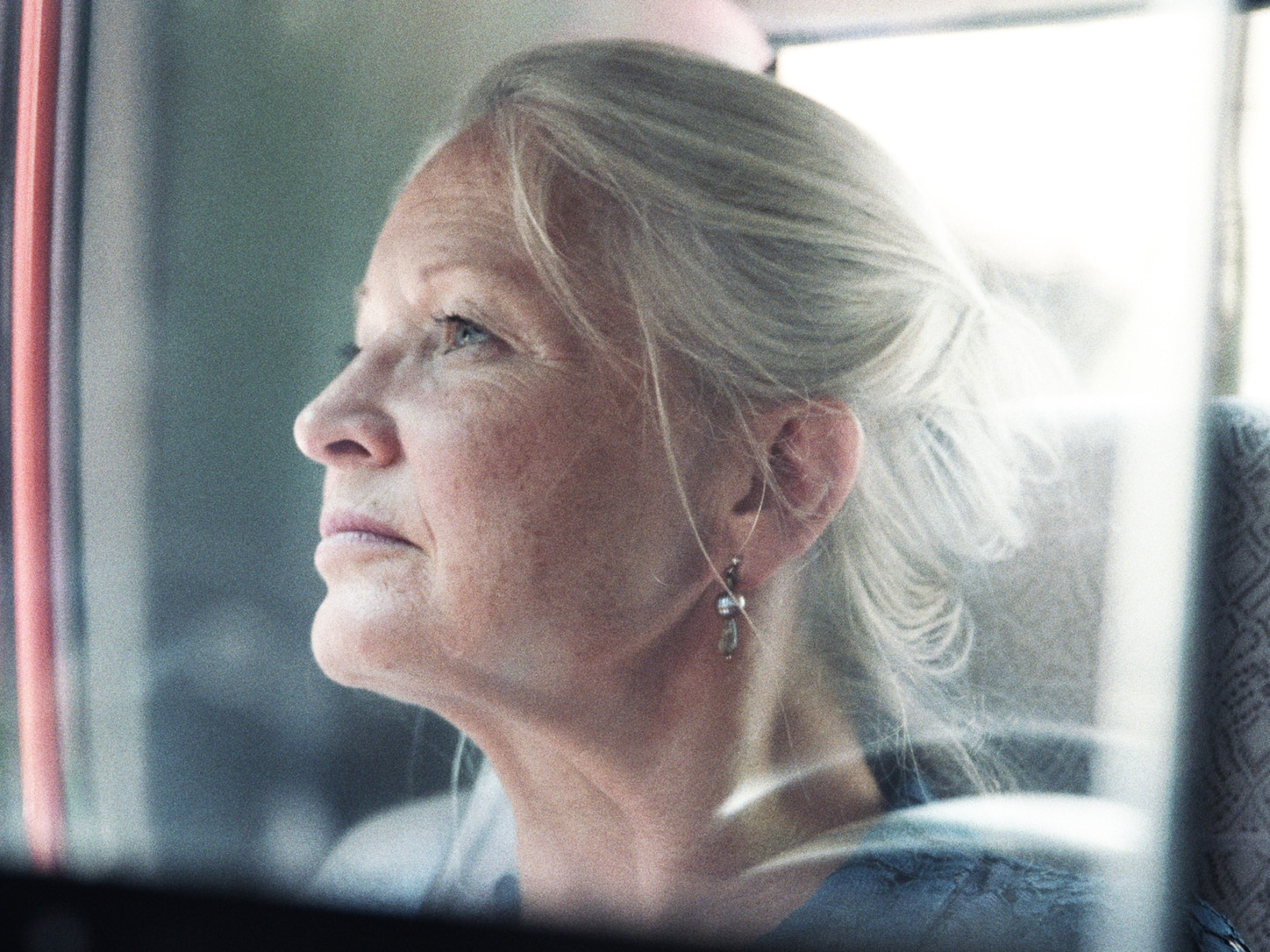
Mette Holm. Still image from the film Dreaming Murakami. Credit: Agapi Triantafillidis
“Most translators are invisible,” Mette says. “Normally when you read about a translated book, everyone says the author is such a good writer or what a lovely language. It’s not their language. You have to mention the translator.” Recognition of the translator’s role is something a reader ought to pay, she says. However, she does not speak with any suggestion that a grave injustice has been done. Her sights seem set on a much larger goal.
“I always say to my daughters that they should read books from different cultures,” she says. “It is important; if you didn’t have translations you wouldn’t know anything about other places.”
While on the surface, this reads as a platitude, in actuality the advice is a shortened version of Mette’s biography. Her path into translation started when she finished high school and traveled to France to become a weaver’s apprentice. There, the weaver recommended she read four Japanese books, including a French translation of Yasunari Kawabata’s The House of the Sleeping Beauties. It piqued her interest in visiting Japan and later, Mette followed through on this idea.
After learning Japanese, the first author she translated was Kenzaburo Oe, an early critic of Murakami. Oe was difficult to capture in Danish however. So when she received a scholarship to study in Japan, Mette sought writers closer to her own language. This led her to Murakami’s breakthrough novel, Norwegian Wood.
“I liked the people, the humor, the sadness,” she remembers. “I bought a small English translation, gave this to the biggest publisher in Denmark and asked them to consider publishing him.”
Her enthusiasm was not reciprocated. Publishers were not confident Murakami would become a “big writer.” Nonetheless, she persevered, writing instead a version of his 607-page tome The Wind-Up Bird Chronicles. It took more than a year. Everything was written by hand. She would consult with other versions, including Jay Rubin’s US translation, though that was four and a half chapters shorter than the original.
“I thought I had a wrong version. I wrote to an agent who wrote to Murakami, who said he would prefer if I translate the full Japanese version. For parts, nobody could check my language.”
The notion of being entirely alone and in the dark could be daunting. Confidence is crucial on the translator’s part, not only in the ability to switch languages, but to walk in the author’s shoes and capture the mood of their prose. “Stalking” is how Mette describes it. She might occasionally seek Murakami’s advice, but more often, she enters his world by herself, sometimes getting a feel for these places by recreating certain experiences from his plots.
“I just translated Killing Commendatore and went into the middle of town with a portrait painter. I would sit translating on the wall. He would paint passers-by. I got the same feeling as the painter in the book, this fear of not painting people the way they like or see themselves. Just sitting at my table, on my computer, I do for hours. Sometimes it’s nice to get out and make a life of it.”
In Dreaming Murakami, a similar action is shown as Mette studies 1970s vintage pinball machines, which feature prominently in the author’s first two books. On a visual level, her scrutinizing over each specific noise produced by these archaic arcade games is hypnotic. It defies our assumptions about the art. Not only on the viewer’s part. Mette herself had an entirely different perception of what might work as a representation of her process.
“I wanted Nitesh to do time-lapses of me sitting and working,” she says. “I thought that was important.”
“My old idea of translation was sitting at a laptop with the original transcript and a dictionary,” Nitesh says in agreement.
“But when I heard Mette talk, it wasn’t so much about sitting. I saw her as this metaphysical medium. She’s putting her left hand on the Japanese signs that I cannot understand and putting her right hand out to create sentences that I read, but otherwise wouldn’t have connected with.”
“This is why I am grateful for your work,” Nitesh tells Mette as the interview winds up and they prepare to give a Skype Q and A to an audience of cinemagoers over in New York. “You are such a strong ambassador for Murakami. It has changed my life. I’m in this world with another mindset on how to communicate.”
“That’s what he does,” Mette replies.
“That’s what you bring to readers around the world,” he tells her.
Translating is a lonely battle. How fortunate then are we that some people are still willing to fight it for us?
More information at www.dreamingmurakami.com
Updated On April 26, 2021

